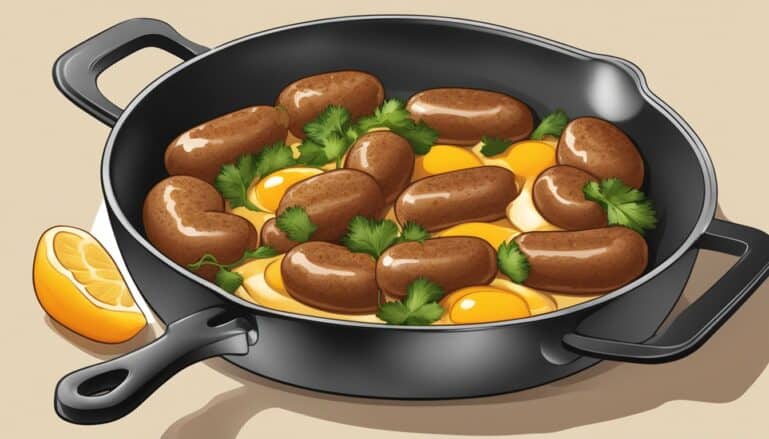How to Cook Breakfast Sausage: A Step-by-Step Guide

Table of Contents
Understanding Breakfast Sausage
Breakfast sausage is a type of sausage that is usually served during breakfast. It is commonly made from ground pork, but it can also be made from chicken, beef, or a combination of meats. Breakfast sausage can be served in various forms such as links or patties.
There are two main types of breakfast sausage: links and patties. Links are long and cylindrical, while patties are flat and round. Both types of breakfast sausage can be made from ground pork, chicken, or beef.
Breakfast sausage patties are usually made from ground pork that has been seasoned with various spices such as salt, pepper, and sage. The ground meat is then formed into patties and cooked in a skillet or on a griddle.
Breakfast sausage links are made in a similar way to patties, but the ground meat is stuffed into a casing to create a cylindrical shape. The links can be cooked in a skillet, on a griddle, or on a grill.
Some breakfast sausages are smoked, which gives them a distinct flavor. Smoked breakfast sausages are usually made from ground pork, but they can also be made from chicken or beef.
Overall, breakfast sausage is a versatile and delicious addition to any breakfast meal.
Ingredients for Breakfast Sausage
When it comes to cooking breakfast sausage, the ingredients you use can make all the difference. Here are the key ingredients I use to make delicious breakfast sausage:
-
Ground pork: The star ingredient of any breakfast sausage recipe. Choose a high-quality ground pork with a good fat content for the best results.
-
Sage: This herb is a classic addition to breakfast sausage, adding a warm, earthy flavor that pairs perfectly with pork.
-
Salt: A must-have ingredient for any sausage recipe, salt helps to enhance the flavor of the pork and other spices.
-
Sweet: To balance out the savory flavors in the sausage, I like to add a touch of sweetness. Brown sugar or maple syrup are great options.
-
Spicy: If you like a little heat in your breakfast sausage, add some red pepper flakes or cayenne pepper.
-
Spices: In addition to sage, I like to add a blend of spices to my sausage, such as paprika, garlic powder, and thyme.
-
Black pepper: A staple in any sausage recipe, black pepper adds depth and complexity to the flavor.
-
Onion: For a little extra flavor, I like to add some finely chopped onion to my sausage mixture.
By using these ingredients in the right proportions, you can create breakfast sausage that is bursting with flavor and perfect for any morning meal.
Nutritional Content of Breakfast Sausage
As a nutritionist, I always recommend people to be aware of the nutritional content of the foods they consume. When it comes to breakfast sausage, it is important to know its nutritional value before adding it to your diet.
Here’s a breakdown of the nutritional content of breakfast sausage:
-
Calories: Breakfast sausage is high in calories, with an average serving size of 2 links containing around 150-200 calories.
-
Cholesterol: Breakfast sausage is also high in cholesterol, with an average serving size of 2 links containing around 30-40 milligrams of cholesterol.
-
Sodium: Breakfast sausage is high in sodium, with an average serving size of 2 links containing around 450-500 milligrams of sodium.
-
Protein: Breakfast sausage is a good source of protein, with an average serving size of 2 links containing around 8-10 grams of protein.
-
Fat: Breakfast sausage is high in fat, with an average serving size of 2 links containing around 12-15 grams of fat.
-
Potassium: Breakfast sausage is not a significant source of potassium.
-
Vitamin A: Breakfast sausage is not a significant source of vitamin A.
As you can see, breakfast sausage is not the healthiest option for breakfast due to its high calorie, cholesterol, and sodium content. However, it can be consumed in moderation as a source of protein and fat. It is important to balance your diet and choose healthier options for breakfast to maintain a healthy lifestyle.

Preparing Breakfast Sausage
When it comes to cooking breakfast sausage, there are a few things to keep in mind to ensure that it turns out perfectly every time. Here are some tips on how to prepare breakfast sausage:
- Remove the sausage from the refrigerator and let it sit at room temperature for about 15 minutes before cooking.
- If your breakfast sausage is in a casing, remove it from the casing before cooking.
- Heat a skillet over medium heat and add the sausage. Cook the sausage for about 2-3 minutes on each side, or until it is browned and cooked through.
- To ensure that the sausage is fully cooked, use a meat thermometer to check the internal temperature. The internal temperature of cooked breakfast sausage should be 160°F (71°C).
- If you are cooking a large amount of sausage, cook it in batches so that it cooks evenly and does not overlap in the pan.
- For best results, cook the sausage in a single layer in the pan. This will ensure that it cooks evenly and browns nicely.
By following these tips, you can prepare delicious breakfast sausage that is perfectly cooked every time.
Cooking Methods for Breakfast Sausage
When it comes to cooking breakfast sausage, there are several methods you can use to achieve a delicious and flavorful result. Here are some popular cooking methods for breakfast sausage:
Pan-Frying
Pan-frying is one of the most common ways to cook breakfast sausage. To pan-fry sausage, heat a nonstick skillet over medium heat, add the sausage links or patties, and cook for about 3-4 minutes per side, or until browned and cooked through. Make sure to flip the sausage frequently to prevent burning.
Baking
Baking is another easy and convenient way to cook breakfast sausage. Preheat your oven to 375°F, place the sausage links or patties on a baking sheet, and bake for 15-20 minutes, or until fully cooked. This method is great for cooking large batches of sausage at once.
Grilling
Grilling is a great way to add some smoky flavor to your breakfast sausage. Preheat your grill to medium-high heat, brush the sausage with a little oil, and grill for about 3-4 minutes per side, or until browned and cooked through. Be sure to watch the sausage closely to prevent burning.
Broiling
Broiling is a quick and easy way to cook breakfast sausage. Preheat your broiler, place the sausage links or patties on a broiler pan, and broil for about 3-4 minutes per side, or until browned and cooked through. Make sure to keep an eye on the sausage to prevent burning.
No matter which method you choose, make sure to cook the sausage to an internal temperature of 160°F to ensure it is fully cooked and safe to eat. Enjoy your delicious breakfast sausage!
Using Oils in Cooking Breakfast Sausage
When it comes to cooking breakfast sausage, using oil can be a great way to ensure that the sausage cooks evenly and doesn’t stick to the pan. There are a few different oils you can use when cooking breakfast sausage, including olive oil and vegetable oil.
One thing to keep in mind is that breakfast sausage is already relatively high in fat, so adding additional oil may not be necessary. However, if you do decide to use oil, here are a few tips to keep in mind:
-
Olive oil can add a nice flavor to the sausage, but it has a relatively low smoke point, so it may not be the best choice for high-heat cooking. If you do use olive oil, be sure to keep the heat on the lower side to prevent the oil from smoking.
-
Vegetable oil is a good all-purpose oil that can be used for cooking breakfast sausage. It has a higher smoke point than olive oil, so it can handle higher temperatures without smoking.
-
If you’re concerned about the fat content of the sausage, you can try using a non-stick cooking spray instead of oil. This can help prevent sticking without adding extra fat to the dish.
Overall, using oil can be a helpful way to ensure that your breakfast sausage cooks evenly and doesn’t stick to the pan. Just be sure to choose an oil with a high enough smoke point and use it sparingly to avoid adding too much extra fat to the dish.
Ensuring Properly Cooked Sausage
As someone who has cooked breakfast sausage countless times, I know that ensuring it is properly cooked is crucial for both taste and safety. Here are some tips to help you achieve perfectly cooked breakfast sausage every time.
Use a Meat Thermometer
The most reliable way to ensure that your breakfast sausage is fully cooked is by using a meat thermometer. The internal temperature of the sausage should reach at least 160°F (71°C) to kill any harmful bacteria. Insert the thermometer into the center of the sausage to get an accurate reading.
Check for Pink Color
While using a meat thermometer is the most accurate way to check for doneness, you can also use visual cues. Cooked breakfast sausage should be browned on the outside and have no pink color on the inside. If you see any pink, continue cooking until it is fully browned.
Follow USDA Guidelines
The United States Department of Agriculture (USDA) recommends cooking breakfast sausage to an internal temperature of 160°F (71°C) to ensure it is safe to eat. Following these guidelines will help prevent foodborne illness.
In summary, to ensure properly cooked breakfast sausage, use a meat thermometer, check for no pink color, and follow USDA guidelines. By doing so, you can enjoy delicious and safe breakfast sausage every time.

Serving Breakfast Sausage
When it comes to serving breakfast sausage, there are many options to choose from. Here are some ideas to get you started:
-
On its own: Breakfast sausage is delicious all by itself. Serve it hot and crispy for maximum enjoyment.
-
In a sandwich: Breakfast sausage makes a great addition to any breakfast sandwich. Layer it with eggs, cheese, and other toppings for a hearty meal.
-
With biscuits: Breakfast sausage and biscuits are a classic pairing. Serve the sausage alongside moist and tender biscuits for a satisfying breakfast.
-
With gravy: Biscuits and gravy is another classic breakfast dish that pairs well with breakfast sausage. Serve the sausage alongside creamy gravy for a delicious and filling meal.
-
On pancakes or waffles: For a sweet and savory breakfast, serve breakfast sausage alongside pancakes or waffles. The combination of crispy sausage and fluffy pancakes is sure to please.
-
With toast or English muffins: For a simple breakfast, serve breakfast sausage alongside toast or English muffins. This is a great option for those who prefer a lighter breakfast.
-
With eggs and hash browns: Breakfast sausage is a great addition to any egg dish. Serve it alongside fried or scrambled eggs and crispy hash browns for a filling breakfast.
Overall, breakfast sausage is a versatile ingredient that can be served in many ways. Experiment with different combinations to find your favorite way to enjoy it.
Storing and Reheating Breakfast Sausage
When it comes to storing breakfast sausage, it’s important to keep it in a safe and hygienic manner to avoid any contamination. Here are some tips on how to store and reheat breakfast sausage:
Freezing and Refrigerating
If you have leftover breakfast sausage, you can store it in the fridge for up to 4 days. However, if you want to keep it for a longer period, you can freeze it for up to 2 months. Make sure to wrap it tightly with aluminum foil or parchment paper to prevent freezer burn.
Storing
When storing breakfast sausage, make sure to place it in an airtight container or a resealable plastic bag to keep it fresh. You can also store it in the fridge or freezer, depending on how long you want to keep it.
Leftovers
If you have leftover breakfast sausage, it’s important to store it properly. You can place it in an airtight container or a resealable plastic bag and store it in the fridge for up to 4 days. If you want to keep it for a longer period, you can freeze it for up to 2 months.
Reheating
When reheating breakfast sausage, make sure to do it properly to avoid any contamination. You can reheat it in the microwave, oven, or on the stovetop. Make sure to heat it until it’s piping hot and reaches an internal temperature of 165°F.
In conclusion, storing and reheating breakfast sausage is easy as long as you follow these tips. Whether you’re storing it in the fridge or freezer, make sure to wrap it tightly to keep it fresh. When reheating, make sure to heat it until it’s piping hot and reaches an internal temperature of 165°F for safe consumption.
Buying and Using Store-Bought Sausage
When it comes to cooking breakfast sausage, using store-bought sausage can be a convenient option. Here are some tips for buying and using store-bought sausage:
- Look for sausages that are labeled as breakfast sausage. These sausages are typically made with ground pork and seasoned with spices like sage, thyme, and black pepper.
- Check the ingredient list for any additives or preservatives. Some sausages may contain nitrates or nitrites, which are used to preserve the meat and give it a pink color. While these additives are generally considered safe, some people prefer to avoid them.
- Choose sausages that are uniform in size and shape. This will help ensure that they cook evenly.
- If you’re cooking on an iron skillet, preheat it over medium heat before adding the sausage. This will help prevent sticking and ensure that the sausage cooks evenly.
- Alternatively, you can bake the sausages on a sheet pan in the oven. Preheat the oven to 375°F and place the sausages on a sheet pan lined with parchment paper. Bake for 20-25 minutes, or until the sausages are cooked through and browned on the outside.
- When cooking sausage, avoid overcrowding the pan or sheet pan. This can cause the sausages to steam rather than brown, resulting in a less desirable texture.
- Use tongs to turn the sausages occasionally while cooking. This will help ensure that they cook evenly on all sides.
- When the sausages are done cooking, use a meat thermometer to check that they have reached an internal temperature of 160°F. This will ensure that they are fully cooked and safe to eat.
By following these tips, you can make delicious breakfast sausages using store-bought sausage.